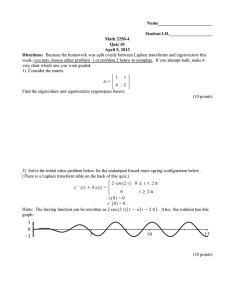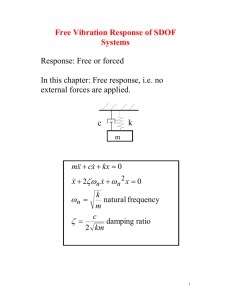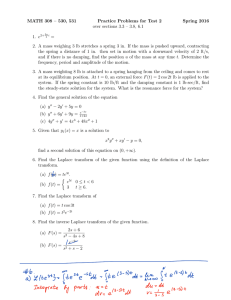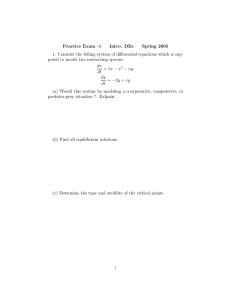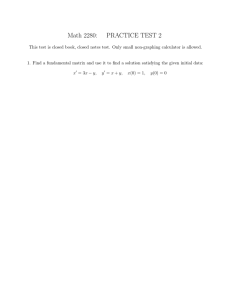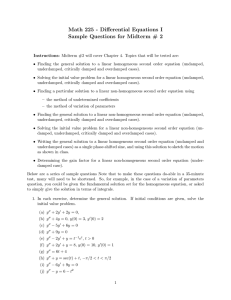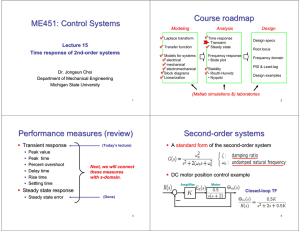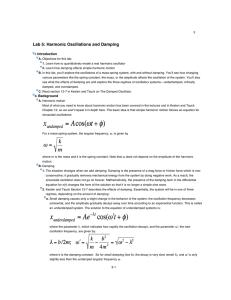Step response using Laplace transform First order systems Problem
advertisement
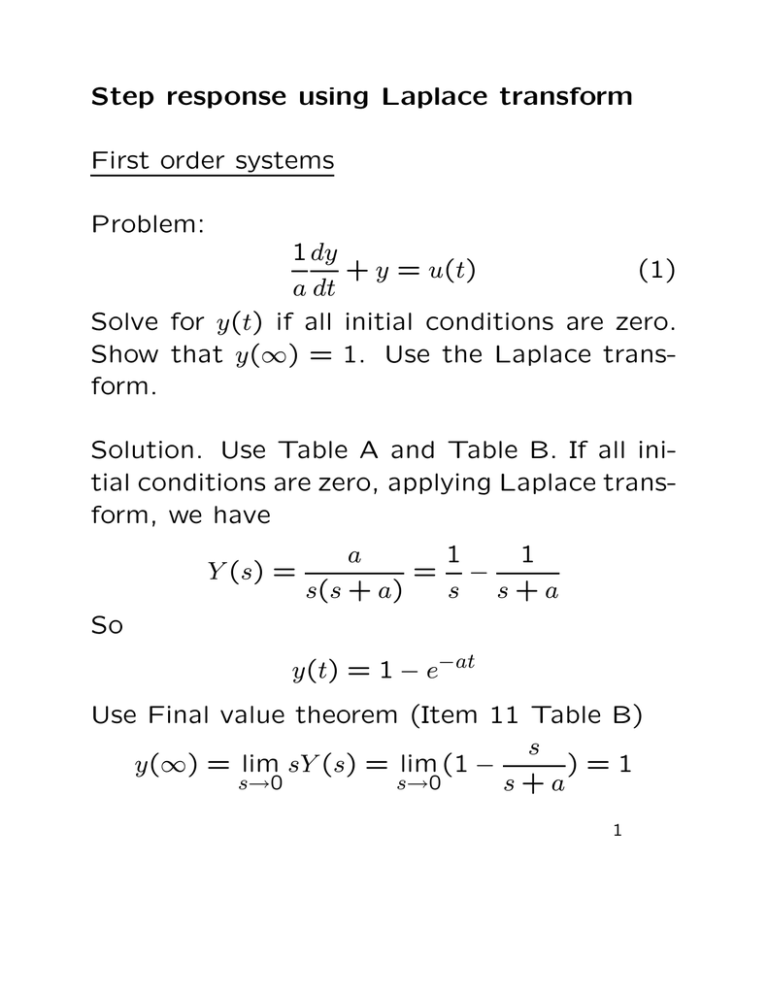
Step response using Laplace transform First order systems Problem: 1 dy + y = u(t) (1) a dt Solve for y(t) if all initial conditions are zero. Show that y(∞) = 1. Use the Laplace transform. Solution. Use Table A and Table B. If all initial conditions are zero, applying Laplace transform, we have Y (s) = 1 1 a = − s(s + a) s s+a So y(t) = 1 − e−at Use Final value theorem (Item 11 Table B) s y(∞) = lim sY (s) = lim (1 − )=1 s→0 s→0 s+a 1 General second order systems Problem: If all initial conditions are zero. Find the general function form of y(t) for the general second order system 1 d2y dy 2 ( + 2ζω + ω y) = u(t) n n 2 2 ωn dt dt where ωn is called the natural frequency. ζ is the damping ratio. Solve the problem in each of the following cases: 1. ζ > 1 (overdamped) 2. ζ = 1 (critically damped) 3. 0 < ζ < 1 (underdamped) 4. ζ = 0 (undamped) respectively. 2 Solution: Use Table A and Table B. If all initial conditions are zero, applying Laplace transform, we have Y (s) 2 ωn Y (s) = 2) s(s2 + 2ζωns + ωn (i) ζ > 1 (overdamped) 2 = (s + σ )(s + σ ) s2 + 2ζωn s + ωn 1 2 where σ1 = ζωn + q σ2 = ζωn − q ζ 2 − 1ωn ζ 2 − 1ωn are real and distinct (Case 1). Y (s) = K1 K2 K3 + + s s + σ1 s + σ2 The general form of y(t) is y(t) = K1 + K2e−σ1t + K3e−σ2t 3 (ii) ζ = 1 (critically damped) 2 s2 + 2ζωn s + ωn = (s + σ)2 where σ = ωn are real and repeated (Case 2). K2 K3 K1 + + Y (s) = 2 s (s + σ) s+σ The general form of y(t) is y(t) = K1 + K2te−σt + K3e−σt 4 (iii) 0 < ζ < 1 (Undamped) 2 s2 + 2ζωn s + ωn = (s + σ1)(s + σ2) where q σ1 = ζωn + j 1 − ζ 2ωn q σ2 = ζωn − j 1 − ζ 2ωn are complex (Case 3). Partial fraction expansion of Y (s) 2 K1 K2s + K3 ωn = + 2) 2 s(s2 + 2ζωn s + ωn s s2 + 2ζωn s + ωn Find K1, K2, K3 2 ωn K1 = 2 | =1 2 s→0 s + 2ζωn s + ωn 5 2 2 ωn = (s2 + 2ζωn s + ωn ) + s(K2s + K3) Balancing the coefficients for s1 and s2, s1 : s2 : 0 = 2ζωn + K3 0 = 1 + K2 K2 = −1, K3 = −2ζωn . Then we have 1 s + 2ζωn Y (s) = − 2(1 − ζ 2 ) s (s + ζωn )2 + ωn 1 = − s q s + ζωn + (ωn 1 − ζ 2) √ ζ 1−ζ 2 2 (1 − ζ 2 ) (s + ζωn )2 + ωn The general form of y(t) is y(t) = 1 − e −ζωn t cos(ωn p ζ 2 1 − ζ t) + 1 p 1 − ζ2 sin(ωn p 1 − ζ 2t) q =1−q e−ζωn t cos(ωn 1 − ζ 2t − φ) 1 − ζ2 where φ = arctan( √ ζ 1−ζ 2 ). 6 ! (iv) ζ = 0 (Undamped) 2 2 s2 + 2ζωn s + ωn = s2 + ωn where two complex roots are +jωn and −jωn, still Case 3. Partial fraction expansion of Y (s) 2 ωn K1 K2s + K3 = + 2) 2 s(s2 + ωn s s2 + ωn Find K1 = 1 as usual. Find K2, K3 2 2 ωn = (s2 + ωn ) + s(K2s + K3) Balancing the coefficients for s1 and s2, s1 : 0 = K3 s2 : 0 = 1 + K2 K2 = −1, K3 = 0. Then we have Y (s) = s 1 − 2 s s + ωn y(t) = 1 − cos ωnt 7 Figure above: Second order system response as a function of damping ratio. 8 Underdamped second order systems Figure below: Second order underdamped response y(t) for damping ratio values. y(t) = 1 − q 1 1 − ζ2 q e−ζωn t cos(ωn 1 − ζ 2t − φ) where φ = arctan( √ ζ 1−ζ 2 ). Peak time Tp is found by differentiating y(t) and then the first zero crossing after t = 0. 2 d ωn L[ y(t)] = sY (s) = 2 2) dt (s + 2ζωn s + ωn = √ ωn 1−ζ q 2 ω 1 − ζ n 2 2 (1 − ζ 2 ) (s + ζωn )2 + ωn 9 d ωn q e−ζωn t sin(ωn 1 − ζ 2t) = 0 y(t) = dt 1 − ζ2 q q ωn 1 − ζ 2t = π Tp = π q ωn 1 − ζ 2 The maximum ymax is √ −ζπ/ y(Tp) = 1 − e 1−ζ 2 The final value y(∞) = 1. Thus √ ymax − y(∞) −ζπ/ 1−ζ 2 =e × 100 %OS = y(∞) We can similarly found that the settling time (defined as the time required to settle with ±2% of the final value) can be approximated 4 . by Ts = ζω n 10 Figure above: underdamped part; (b) with with constant Step responses of second order systems. (a) with constant real constant imaginary part and (c) damping ratio. 11
